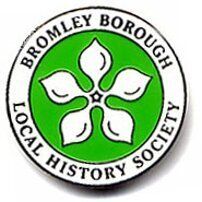Bromley Borough Local History Society
Registered Charity
No. 273 963

Bromley Borough Local History Society
The name Hayes is recorded from 1177 as hoese from the Anglo-Saxon meaning "a settlement in open land overgrown with shrubs and rough bushes". It formed an ancient, and later civil, parish of Kent of around 1,282 acres The village stood at the junction of Hayes Lane, leading north to Bromley (one mile distant), and what is now known as Pickhurst Lane, leading west to West Wickham. The centre of the old village is now called Hayes Street. The village school was here, as is the parish church of St Mary the Virgin. Parts of the church date back to the thirteenth century; however it was subject to heavy restorations by George Gilbert Scott and John Oldrid Scott in the nineteenth century. The public house, also on Hayes Lane, is called "The George" (first recorded 1759 ). Hayes Street Farm, still shown on modern maps, is to the north of the village centre.
Both William Pitt the Elder, 1st Earl of Chatham (1708–1778), and William Pitt the Younger (1759–1806) lived at Hayes Place.[7] The house was demolished in 1933 and the site redeveloped, but its occupants are remembered in such road names as Chatham and Pittsmead Avenues. Prior to being demolished, Hayes Place was owned by the Hambro family (of Hambros Bank fame) and a couple of roads bear the family names.
Although the parish church of Hayes can trace its history back over 800 years, and local villains joined Jack Cade in his rebellion of 1450, the story of Hayes became significant a little over a century ago, when Hayes became a popular place in which to live because bankers, stockbrokers and those who were "something in the City" bought property in the area.
Between 1801, when the population was just 382, and 1921, it had almost tripled to 1010.
The branch railway from Elmers End, originally known as the West Wickham and Hayes Railway, was opened on 29 May 1882. Hayes station is a terminus.
During the second world war, an anti-aircraft gun battery was locally based on Hayes Common, and the soldiers of the 1st Canadian Division who manned it were barracked in local homes.
Throughout the 20th century, the Hayes village area continued to grow and thrive. Further commercial development occurred on Station Approach because the increased traffic through the railway terminus created an incentive for growth. In the old village area ('Old Hayes'), the former village school was converted to a second, smaller village hall when the local primary school opened in 1937; it lies along George Lane, which was further expanded at around the same time to facilitate further suburban housing developments.
View of Hayes Village with the school for children of all ages on the left.
Hayes Place, built in 1763 for the Earl of Chatham (William Pitt the Elder). The building and nearly 200 acres of land was sold for building development in 1933
Wealthy banker Everard Hambro moved nto Hayes Place in 1882 and became a large land owner and local employer.
The junction of Baston and West Common roads surround Mr. Russell's drapery shop with the school in the centre distance.
the George, Hayes